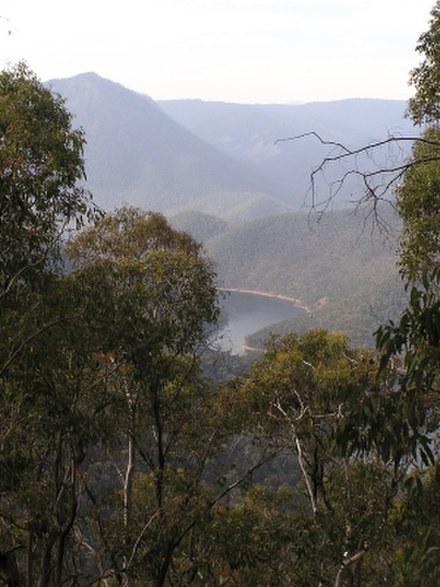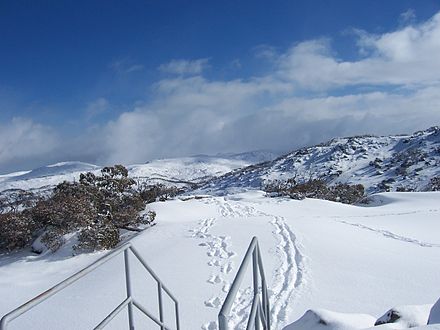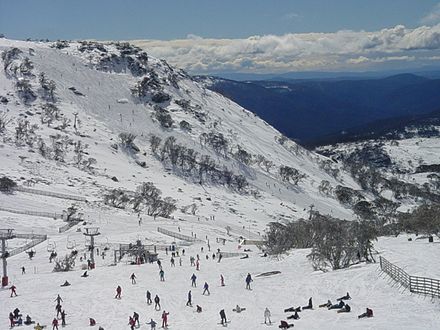Snowy Mountains - region of New South Wales, Australia
For other "snowy mountains" see Sierra Nevada (disambiguation), for example.

The Snowy Mountains, nicknamed the Snowies (or Snowys), is a region in Southeastern New South Wales. The highest region of mainland Australia and one of the cooler areas of New South Wales, they are notable for their ski-fields and are the centre of snow sports in New South Wales.
Understand
The Snowies are possibly the best you could get in terms of alpine weather in mainland Australia (alpine weather is also easily found in New Guinea and New Zealand, and can arguably be considered better, although that varies on opinion). While the mountains here are nowhere near as tall as New Guinea's 4500-m mountain range, those don't receive as much snowfall as the Snowies. Interestingly, the Australian Alps receive more snowfall than the Swiss alps, which sounds unusual to most.
Flora and fauna
The usual alpine vegetation, as well as kangaroos, dingos, etc.
Cities
- Adaminaby
- Berridale 📍
- Bombala
- Cooma 📍
- Jindabyne 📍 – just below the snowline
- Khancoban 📍
- Tumut 📍 – on the border with the Riverina region, this town is an entry to the Snowy Mountains
Other destinations
- Charlotte Pass 📍 – village and ski resort, snowbound in winter
- Perisher 📍 – ski resort, based at Perisher Valley, but also including Guthega, and ski fields at Smiggins Holes and Mount Blue Cow
- Thredbo 📍 – village and ski resort, the best Australia can offer for an alpine village
- Kosciuszko National Park 📍 – home to the highest mountain on the Australian continent
- Alpine Way – scenic road that runs from Jindy to Khancoban.
- Yarrangobilly Caves
Get in
The Snowy Mountains are on Australia's eastern seaboard and are equidistant from Sydney and Melbourne.
Most people travel to the region by car as this is the most flexible and rewarding way of exploring the mountains. However for visitors traveling from afar, there are regular bus services to Cooma and Tumut from Sydney and Canberra, and many plane connections into Canberra (IATA: CBR) with car hire available. Flights also serve Cooma Snowy Mountains Airport (IATA: OOM), however, delays are common due to morning fog.
The Snowies are well served by a network of sealed roads with diverse and spectacular scenery. The Alpine Way from Jindabyne to Khancoban, the Snowy Mountains Highway between Tumut and Cooma, the Monaro Highway running south from Canberra and the Elliot Way from Tumbarumba to Cabramurra all pass through stunning landscapes.
If you are just interested in the skiing, Murrays offer a day trip from Canberra to the ski resorts during the ski season, with lift packages, and one-way fares available. Often you can get this bus for little more than the cost of the lift passes and ski hire.
If you are coming from the south via Khancoban, make sure to fill up at the Caltex there since that will be the last stop for Alpine Diesel or even just normal fuel for the mountain drive up north which takes 78km and 2 hours. There are numerous coffee shops nearby as well, so your cup of coffee or hot chocie won't be missed. This is also the only part where you might see snow on the road throughout winter, due to the high altitude of 1600m, but the entire journey's altitude ranges from 250m in Khancoban to about 1600m in Siberia.
Get around
During winter snow chains must be carried by 2WD vehicles on the Alpine Way, Kosciuszko Rd and Guthega Road. Some roads may close at short notice, so check conditions on the official New South Wales traffic site.
When in town, it's best to walk rather than take the car. Cars can be freezing in the mornings, and often it's not worth the effort to take it out and park it. When climbing up, gondolas are also available, however, passes are required.
There's no public transport in towns and there are also no taxis in the ski resorts. The nearest fully run airport is in Cooma IATA: OOM, however to get around, flights wont do the job, so you'll need to know how to drive, and not just urban driving, but also driving on narrow winding roads that vary in altitude. See driving in New Zealand for some useful advice.
See

The Snowy Mountains is a significant and untamable high country where many Australian myths and traditions of Australian identity were born. Whether from nature's pure beauty or legends of early settlers, there's a story to be told and history to be learnt - from icons like the heights of Mount Kosciuszko to the famous high country huts, to Snowy Hydro feats of ingenuity, beautiful mountain brumbies and to rivers that flow with legends.
The Snowy Mountains Scheme is one of Australia's largest engineering and construction operations. The ideas behind the scheme is to divert the winter snowmelt waters westward into the Murrumbidgee rivers, irrigating large parts of inland Australia and at the same time generating Hydro-Electricity. There are several large lakes, tunnels, and Hydro power stations that form part of the scheme that you can visit. Tours take visitors a kilometre into the mountainside and offer a vivid insight into the sheer scope of this iconic part of the nation's post-war development.
You can see the headwaters of the Murray River at Tom Groggin, along the Alpine Way between Thredbo and Khancoban.
Do

The mountains are beautiful year round and the region annually attracts some three million visitors seeking nature-based and adventure holidays.
If you've come this far, you can't go home without doing some form of snow-related activity. Skiing is by far the most common activity, but snowboarding is still very popular. If it's your first time visiting the Snowy Mountains, most beginner skiers choose to ski at one of the state's two main ski resorts: Perisher and Thredbo. For skiers up for a challenge, Charlotte Pass or Cabramurra are two off-the-beaten-track ski resorts designed for skiers with previous skiing experience.
Whether you're after a rugged back-to-nature experience, want to be cosseted in alpine splendor or simply feel like going somewhere beautiful, diverse and interesting with the whole family, the chances are high that you'll find it in the Snowy Mountains. Attractions, outdoor activities, tours and events - the Snowy Mountains has it all.
- Abseiling, rock climbing and caving
- Bushwalking, the top of Australia is only a few hours hiking from Charlotte Pass or Thredbo during summer via the many Mount Kosciuszko summit trails.
- Cycling/mountain biking and motorcycling
- Fishing
- Horse riding
- White water rafting, kayaking and canoeing
- In winter, alpine skiing and snowboarding. Thredbo, Perisher, Mount Selwyn, or Charlotte Pass all have a large variety of terrain for beginners to advanced. You can ski with gum trees. Snow shoeing and cross country skiing: see also Winter sports in Australia

- A wide variety of Backcountry/off-piste skiing/spit boarding options are available and easily accessible from Guthega and Dead Horse Gap.
- Snowy Mountains Backcountry, +61 400 349 319. Guided backcountry skiing/snowboarding/snowshoeing tours, equipment hire and sales. 2020-09-02
Buy
For supplies, large towns like Cooma or Tumut should have a Woolies (Woolworths) or a Coles. If in a small town, then there are smaller local shops for you to get your supplies from.
To get ski equipment, renting equipment is often cheaper at cities or large towns and in some cases, the equipment may be of better quality. Snow chains are also cheaper to rent here, and some shops are open 24 hours a day. However, if you can't have access to one of these towns, then equipment is available at the ski. However, these can be a little expensive and have a lower quality.
Eat
There are many places to eat and drink in the Snowy Mountains. Cafes are scattered all around the towns, including the mountain resorts at Thredbo or Perisher.
Finding good food in big towns like Jindabyne or Cooma is usually not a problem. These towns have a diverse range of good restaurants, cafes and eating establishments in general. Food prices are also reasonable, mainly because these towns are more accessible and well below the snow line.
Although you can find good food in the towns, it is very limited in Thredbo and Perisher Valley, and even more so in more remote ski resorts like Charlotte Pass or Blue Cow. They tend to be sparse, expensive, and in winter, very crowded (although this is true at all ski resorts). High quality food is available, but expect to find a fair amount of low-quality expensive food. In particular the cheap foods, like pizza, can be on the expensive side in the mountains with less competition.
In other non-tourist towns like Bombala or Talbingo, variety tends to be limited but often inexpensive. Usually you will find a few cafes and one or two restaurants.
Drink
Most towns usually have at least one pub. However, don't be surprised to see it fully packed during the snow season, where people are packed together, staying warm.
Unlike most cities, pubs are not violent here, and you wont be hearing a bunch of offensive comments, but rather everyone being quiet here.
Sleep
There are many places to stay in the Snowies, from romantic chalets with open fires to self-catering accommodation ideal for families, luxury resorts to fun-filled backpackers, hotels, motels and cosy B & Bs.
Go next
The Snowy Mountains area is in New South Wales, which holds tons of great activities, and is also near the Australian capital, Canberra. If you want to experience more snow on the other side of the border, High Country is just on the other side of the Murray.
New South Wales
Primary administrative division